| Listing 1 - 9 of 9 |
Sort by
|
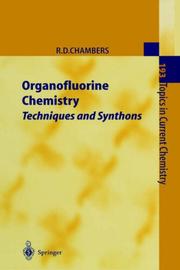
ISSN: 03401022 ISBN: 3540631704 3540691979 9783540631705 Year: 1997 Volume: 193 Publisher: Berlin Springer
Abstract | Keywords | Export | Availability | Bookmark
 Loading...
Loading...Choose an application
- Reference Manager
- EndNote
- RefWorks (Direct export to RefWorks)
Organofluorine compounds. --- Composés organiques fluorés --- Composes organiques fluores --- Chemistry. --- Organic chemistry. --- Optics. --- Optoelectronics. --- Plasmons (Physics). --- Organic Chemistry. --- Optics, Optoelectronics, Plasmonics and Optical Devices. --- Composés organiques fluorés --- Organofluorine compounds --- Lasers. --- Photonics. --- Optics, Lasers, Photonics, Optical Devices. --- New optics --- Optics --- Light amplification by stimulated emission of radiation --- Masers, Optical --- Optical masers --- Light amplifiers --- Light sources --- Optoelectronic devices --- Nonlinear optics --- Optical parametric oscillators --- Organic chemistry --- Chemistry --- Fluorine organic compounds --- Fluorine compounds --- Organohalogen compounds

ISBN: 0792346238 9401063133 9401154961 Year: 1997 Volume: v. 36
Abstract | Keywords | Export | Availability | Bookmark
 Loading...
Loading...Choose an application
- Reference Manager
- EndNote
- RefWorks (Direct export to RefWorks)
The Workshop on Physics and Application of Non-crystalline Semiconductors in Optoelectronics was held from 15 to 17 October 1996 in Chisinau. republic of Moldova and was devoted to the problems of non-crystalline semiconducting materials. The reports covered two mjlin topics: theoretical basis of physics of non -crystalline materials and experimental results. In the framework of these major topics there were treated many subjects. concerning the physics of non-crystalline semiconductors and their specific application: -optical properties of non-crystalline semiconductors; -doping of glassy semiconductors and photoinduced effects in chalcogenide glasses and their application for practical purposes; -methods for investigation of the structure in non-crystalline semiconductors -new glassy materials for IR trasmittance and optoelectronics. Reports and communications were presented on various aspects of the theory. new physical principles. studies of the atomic structure. search and development of optoelectronics devices. Special attention was paid to the actual subject of photoinduced transformations and its applications. Experimental investigations covered a rather wide spectrum of materials and physical phenomena. As a novel item it is worth to mention the study of nonlinear optical effects in amorphous semiconducting films. The third order optical non linearities. fast photoinduced optical absorption and refraction. acusto-optic effects recently discovered in non-crystalline semiconductors could potentially be utilised for optical signal processing. The important problems of photoinduced structural transformations and related phenomena. which are very attractive and actual both from the scientific and practical points of view. received much attention in discussions at the conference.
Engineering & Applied Sciences --- Physics --- Physical Sciences & Mathematics --- Light & Optics --- Applied Physics --- Optoelectronic devices --- Amorphous semiconductors --- Optical properties --- Congresses --- Optics. --- Electrodynamics. --- Electronics. --- Microelectronics. --- Lasers. --- Photonics. --- Electrical engineering. --- Materials science. --- Optical materials. --- Electronic materials. --- Classical Electrodynamics. --- Electronics and Microelectronics, Instrumentation. --- Optics, Lasers, Photonics, Optical Devices. --- Electrical Engineering. --- Characterization and Evaluation of Materials. --- Optical and Electronic Materials. --- Electronic materials --- Optics --- Materials --- Material science --- Physical sciences --- Electric engineering --- Engineering --- New optics --- Light amplification by stimulated emission of radiation --- Masers, Optical --- Optical masers --- Light amplifiers --- Light sources --- Nonlinear optics --- Optical parametric oscillators --- Microminiature electronic equipment --- Microminiaturization (Electronics) --- Electronics --- Microtechnology --- Semiconductors --- Miniature electronic equipment --- Electrical engineering --- Dynamics --- Light --- Noncrystalline semiconductors --- Polycrystalline semiconductors --- Amorphous materials --- Optoelectronic semiconductor devices --- Semiconductor materials
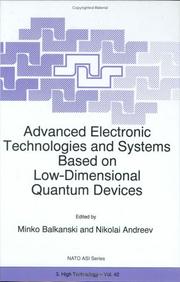
ISBN: 0792348753 9048149649 9401589658 Year: 1997 Volume: 42
Abstract | Keywords | Export | Availability | Bookmark
 Loading...
Loading...Choose an application
- Reference Manager
- EndNote
- RefWorks (Direct export to RefWorks)
This volume on Advanced Electronic Technologies and Systems based on Low Dimensional Quantum Devices closes a three years series of NATO -AS!' s. The first year was focused on the fundamental properties and applications. The second year was devoted to Devices Based on Low-Dimensional Semiconductor Structures. The third year is covering Systems Based on Low-Dimensional Quantum Semiconductor Devices. The three volumes containing the lectures given at the three successive NATO -ASI's constitute a complete review on the latest advances in semiconductor Science and Technology from the methods of fabrication of the quantum structures through the fundamental physics am basic knowledge of properties and projection of performances to the technology of devices and systems. In the first volume: " Fabrication, Properties and Application of Low Dimensional Semiconductors" are described the practical ways in which quantum structures are produced, the present status of the technology, difficulties encountered, and advances to be expected. The basic theory of Quantum Wells, Double Quantum Wells and Superlattices is introduced and the fundamental aspects of their optical properties are presented. The effect of reduction of dimensionality on lattice dynamics of quantum structures is also discussed. In the second volume: " Devices Based on Low Dimensional Structures" the fundamentals of quantum structures and devices in the two major fields: Electro-Optical Devices and Pseudomorphic High Eectron Mobility Transistors are extensively discussed.
Optoelectronic devices --- Congresses --- Quantum electronics --- Switching circuits --- Materials --- Quantum wells --- Electronics. --- Microelectronics. --- Computer hardware. --- Lasers. --- Photonics. --- Electronic circuits. --- Electrical engineering. --- Optical materials. --- Electronic materials. --- Electronics and Microelectronics, Instrumentation. --- Computer Hardware. --- Optics, Lasers, Photonics, Optical Devices. --- Circuits and Systems. --- Electrical Engineering. --- Optical and Electronic Materials. --- Electronic materials --- Optics --- Electric engineering --- Engineering --- Electron-tube circuits --- Electric circuits --- Electron tubes --- Electronics --- New optics --- Light amplification by stimulated emission of radiation --- Masers, Optical --- Optical masers --- Light amplifiers --- Light sources --- Nonlinear optics --- Optical parametric oscillators --- Microminiature electronic equipment --- Microminiaturization (Electronics) --- Microtechnology --- Semiconductors --- Miniature electronic equipment --- Electrical engineering --- Physical sciences
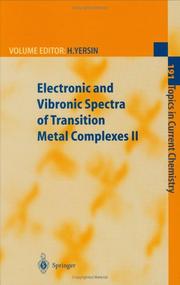
ISBN: 354062922X 3540690476 9783540629221 Year: 1997 Volume: 191 Publisher: Berlin: Springer,
Abstract | Keywords | Export | Availability | Bookmark
 Loading...
Loading...Choose an application
- Reference Manager
- EndNote
- RefWorks (Direct export to RefWorks)
The unique properties and applications of transition metal compounds have long fascinated both physicists and chemists. This volume presents theoretical and experimental studies for a deeper understanding of the electronic and vibronic properties of these compounds. In particular, an introduction into properties of spin sublevels of dd*, dÂ*, and ÂÂ* states is given, and a modern ligand field theory based on the Angular Overlap Model is presented. In experimental case studies it is shown how to characterize different types of electronic transitions using modern methods of laser spectroscopy. Consequences of spin-orbit coupling, zero-field splittings, spin-lattice relaxations, chromophore-matrix interactions, Herzberg-Teller/Franck-Condon activities, and localization/delocalization properties are treated.
Transition metal complexes --- Spectra. --- 541.49 --- #WSCH:AAS2 --- Complex compounds. Complex chemistry --- Chemistry. --- Analytical chemistry. --- Inorganic chemistry. --- Organic chemistry. --- Physical chemistry. --- Optics. --- Optoelectronics. --- Plasmons (Physics). --- Organic Chemistry. --- Physical Chemistry. --- Inorganic Chemistry. --- Optics, Optoelectronics, Plasmonics and Optical Devices. --- Analytical Chemistry. --- 541.49 Complex compounds. Complex chemistry --- Lasers. --- Photonics. --- Optics, Lasers, Photonics, Optical Devices. --- Analysis, Chemical --- Analytic chemistry --- Chemical analysis --- Chemistry, Analytic --- Chemistry --- New optics --- Optics --- Light amplification by stimulated emission of radiation --- Masers, Optical --- Optical masers --- Light amplifiers --- Light sources --- Optoelectronic devices --- Nonlinear optics --- Optical parametric oscillators --- Inorganic chemistry --- Inorganic compounds --- Chemistry, Theoretical --- Physical chemistry --- Theoretical chemistry --- Organic chemistry --- Transition metal complexes - Spectra. --- Electronic transition --- Vibronic transition

ISBN: 3540612750 3662141027 3540683925 9783540612759 Year: 1997 Publisher: Berlin Springer
Abstract | Keywords | Export | Availability | Bookmark
 Loading...
Loading...Choose an application
- Reference Manager
- EndNote
- RefWorks (Direct export to RefWorks)
This Handbook of Nonlinear Optical Crystals is the revised edition of the previous book published in 1991. It provides a complete description of the properties and applications of nonlinear optical crystals. In addition, it presents the most important equations for calculating the main parameteres of nonlinear frequency converters. This comprehensive current reference book is now updated and will be of great value to all scientists and engineers working in nonlinear optics, quantum electronics and laser physics.
621.375 --- 621.375 Amplifiers --- Amplifiers --- Crystals --- Laser materials --- Nonlinear optics --- Optical materials --- Lasers --- Materials --- Crystallography --- Powders --- Solids --- Optics --- Optics, Nonlinear --- Handbooks, manuals, etc --- Lasers. --- Photonics. --- Crystallography. --- Engineering. --- Materials science. --- Optics, Lasers, Photonics, Optical Devices. --- Crystallography and Scattering Methods. --- Engineering, general. --- Characterization and Evaluation of Materials. --- Material science --- Physical sciences --- Construction --- Industrial arts --- Technology --- Leptology --- Mineralogy --- New optics --- Light amplification by stimulated emission of radiation --- Masers, Optical --- Optical masers --- Light amplifiers --- Light sources --- Optoelectronic devices --- Optical parametric oscillators --- Nonlinear optics - Handbooks, manuals, etc --- Crystals - Handbooks, manuals, etc --- Laser materials - Handbooks, manuals, etc --- Optical materials - Handbooks, manuals, etc

ISBN: 3642606350 3540619828 Year: 1997 Publisher: Berlin Springer
Abstract | Keywords | Export | Availability | Bookmark
 Loading...
Loading...Choose an application
- Reference Manager
- EndNote
- RefWorks (Direct export to RefWorks)
Laser application in chemistry and related fields is an area growing at rapid pace in line with new developments in laser technology. The fields of application range from fundamental chemical research to sophisticated analytical methods in chemical and biotechnological industry and in environmental chemistry. This book shows, with detail, the breath of applications of lasers in chemistry, with particular reference to analytical and research applications. D.L. Andrews presents the subject matter at a level amenable to the general chemist, the novice and the practising specialists as well. The 3rd edition of this successful book has been completely revised and updated.
Lasers in chemistry. --- Laser spectroscopy. --- Laser photochemistry. --- Spectrometric and optical chemical analysis --- fysicochemie --- Photochemistry --- Chemical laboratory practice --- 542.8 --- 542.8 Physical, physicochemical and electrical operations --- Physical, physicochemical and electrical operations --- Lasers en chimie --- Spectroscopie à laser --- Laser photochemistry --- Lasers in chemistry --- Laser spectroscopy --- Spectrum analysis --- Chemical apparatus --- Laser chemistry --- Laser-induced chemistry --- Physical chemistry. --- Lasers. --- Photonics. --- Chemistry, Physical and theoretical. --- Analytical chemistry. --- Atoms. --- Physics. --- Materials science. --- Physical Chemistry. --- Optics, Lasers, Photonics, Optical Devices. --- Theoretical and Computational Chemistry. --- Analytical Chemistry. --- Atomic, Molecular, Optical and Plasma Physics. --- Characterization and Evaluation of Materials. --- Material science --- Physical sciences --- Natural philosophy --- Philosophy, Natural --- Dynamics --- Chemistry, Physical and theoretical --- Matter --- Stereochemistry --- Analysis, Chemical --- Analytic chemistry --- Chemical analysis --- Chemistry, Analytic --- Chemistry --- Chemistry, Theoretical --- Physical chemistry --- Theoretical chemistry --- New optics --- Optics --- Light amplification by stimulated emission of radiation --- Masers, Optical --- Optical masers --- Light amplifiers --- Light sources --- Optoelectronic devices --- Nonlinear optics --- Optical parametric oscillators --- Constitution
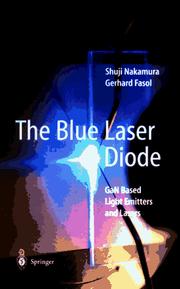
ISBN: 3540615903 3662034646 366203462X 9783540615903 Year: 1997 Publisher: Berlin Springer
Abstract | Keywords | Export | Availability | Bookmark
 Loading...
Loading...Choose an application
- Reference Manager
- EndNote
- RefWorks (Direct export to RefWorks)
Shuji Nakamura recently developed the first commercially available blue and green light emitting diodes. Subsequently he demonstrated the first blue semiconductor laser based on GaN. GaN and its related compounds allow the fabrication of highly efficient light emitters and lasers ranging from red through yellow and green to blue in a single material system. In this book the physical concept and basic manufacturing technology of these new blue light emitting diodes and laser diodes are discussed. The breakthrough in GaN technology opens many new commercial applications for semiconductors, comprising displays, road and railway signalling, lighting, scanners, optical data storage, and much more. This book also gives information on the extraordinary realization of an extremely successful concept of research and development through Nakamura's work. The book appeals to researchers as well as to engineers.
Optics. Quantum optics --- Electronics --- Gallium nitride --- Semiconductor lasers --- Diodes, Semiconductor --- Light emitting diodes --- Blue light --- 621.375 --- Lasers --- LEDs (Light emitting diodes) --- Electroluminescent devices --- LED lamps --- Light-emitting electrochemical cells --- Gallium compounds --- Nitrides --- Crystal diodes --- Diodes, Crystal --- Semiconductor diodes --- Semiconductors --- Light, Blue --- Light, Colored --- Amplifiers --- Blue light. --- Diodes, Semiconductor. --- Gallium nitride. --- Light emitting diodes. --- Semiconductor lasers. --- 621.375 Amplifiers --- Lasers. --- Photonics. --- Quantum optics. --- Optical materials. --- Electronic materials. --- Electronics. --- Microelectronics. --- Optics, Lasers, Photonics, Optical Devices. --- Quantum Optics. --- Optical and Electronic Materials. --- Electronics and Microelectronics, Instrumentation. --- Microminiature electronic equipment --- Microminiaturization (Electronics) --- Microtechnology --- Miniature electronic equipment --- Electrical engineering --- Physical sciences --- Electronic materials --- Optics --- Materials --- Photons --- Quantum theory --- New optics --- Light amplification by stimulated emission of radiation --- Masers, Optical --- Optical masers --- Light amplifiers --- Light sources --- Optoelectronic devices --- Nonlinear optics --- Optical parametric oscillators

ISBN: 0792347366 9401063559 9401155860 Year: 1997 Volume: 40
Abstract | Keywords | Export | Availability | Bookmark
 Loading...
Loading...Choose an application
- Reference Manager
- EndNote
- RefWorks (Direct export to RefWorks)
Since their inception more than 2.5 years ago, photon correlation techniques for the spatial, temporal or spectral analysis of fluctuating light fields have found an ever-widening range of applications. Using detectors which re spond to single quanta of the radiation field, these methods are intrinsically digital in natnre and in many experimental situations offer a unique degree of accuracy and sensitivity, not only for the study of primary light sources themselves, but most particularly in the use of a laser-beam probe to study light scattering from pure fluids, macromolecular suspensions and laminar or turbulent flowing fluids and gases. Following the earliest developments in laser scattering by dilute macro nl01ecular suspensions, in , ... hich particle sizing was the main aim, and the use of photon correlation techniques for laser-Doppler studies of flow and tnrbuence. both of which areas were the subject of NATO ASls in Capri, Italy in 19;:3 and 19;6. significant advances have be('n made in recent years in many other areas. These were reflected in the topics covered in this NATO Advanced Research Workshop, which took place from August 2;th to 30th, 1!)!}6, at the Jagiellonian University, Krakow, Poland. These in cluded ('xperimental techniques. statist.ics and data reduction, colloids and aggregation, polymers, gels, liquid crystals and mixtures, protein solutions, critical pllf'nomena and dense media.
Light beating spectroscopy --- Congresses --- Light --- Scattering --- Optics. --- Electrodynamics. --- Lasers. --- Photonics. --- Physical chemistry. --- Analytical chemistry. --- Condensed matter. --- Classical Electrodynamics. --- Optics, Lasers, Photonics, Optical Devices. --- Physical Chemistry. --- Analytical Chemistry. --- Condensed Matter Physics. --- Condensed materials --- Condensed media --- Condensed phase --- Materials, Condensed --- Media, Condensed --- Phase, Condensed --- Liquids --- Matter --- Solids --- Analysis, Chemical --- Analytic chemistry --- Chemical analysis --- Chemistry, Analytic --- Chemistry --- Chemistry, Theoretical --- Physical chemistry --- Theoretical chemistry --- New optics --- Optics --- Light amplification by stimulated emission of radiation --- Masers, Optical --- Optical masers --- Light amplifiers --- Light sources --- Optoelectronic devices --- Nonlinear optics --- Optical parametric oscillators --- Dynamics --- Physics --- Photon correlation spectroscopy --- Spectroscopy, Light beating --- Spectroscopy, Photon correlation --- Laser spectroscopy --- Quantum optics --- Spectrum analysis --- COLLOIDS --- LIGHT SCATTERING --- POLYMERS --- GELS --- LIQUID CRYSTALS --- DATA PROCESSING --- PHASE SEPARATION --- CRITICAL PHENOMENA --- PROPERTIES
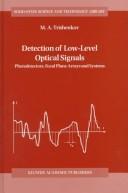
ISBN: 0792346912 9048148928 9401512906 Year: 1997 Publisher: Dordrecht Kluwer
Abstract | Keywords | Export | Availability | Bookmark
 Loading...
Loading...Choose an application
- Reference Manager
- EndNote
- RefWorks (Direct export to RefWorks)
This book is addressed to designers of photodetectors and photodetecting systems, designers of focal plane arrays, charge-coupled devices, specialists in IR technologies, designers of optoelectronic detecting, guiding and tracking systems, systems for IR direction finders, lidars, lightwave communication systems, IR imagers. All these specialists are united by one common purpose: they are all striving to catch the weakest possible optical signal. The most important characteristic of photosensitive devices is their detectivity, which determines the lowest level of optical signal they are able to detect above the noise level. These threshold characteristics define the most important tactical and technical parameters of the entire optoelectronic system, such as its range, resolution, precision. The threshold characteristics of optoelectronic system depend on many of its components; all designers agree, however, that the critically responsible part of the system is the photodetector [1]. By the end of the 1960s the physicists and the engineers were able to overcome many obstacles and to create photodetectors (at least single-element or few-element ones) which covered all the main optical bands (0. 4 . . . 2,2 . . . 3, 3 . . . 5,8 . . . 14 J. . Lm), carried out the detection almost without any loss (the quantum yield being as high as 0. 7 . . . 0. 9), and reduced the noise level to the lowest possible limit.
Charge coupled devices. --- Focal planes. --- Optical detectors. --- Optoelectronic devices. --- Signal processing. --- Charge coupled devices --- Focal planes --- Optical detectors --- Optoelectronic devices --- Signal processing --- Photo electric devices --- Photo electronic devices --- Photoelectronic devices --- Electronic apparatus and appliances --- Optical instruments --- Electrooptical devices --- Integrated optics --- Light-sensitive cells --- Light-sensitive detectors --- Light sensor photodevices --- Photodetectors --- Photodevices, Light sensor --- Photoelectric detectors --- Photosensors --- Detectors --- Optical transducers --- Processing, Signal --- Information measurement --- Signal theory (Telecommunication) --- Planes, Focal --- Optics --- CCD (Electronics) --- Image converters --- Integrated circuits --- Charge transfer devices (Electronics) --- Metal oxide semiconductors --- Equipment and supplies --- Lasers. --- Photonics. --- Electrical engineering. --- Optical data processing. --- Optical materials. --- Electronic materials. --- Automotive engineering. --- Optics, Lasers, Photonics, Optical Devices. --- Electrical Engineering. --- Image Processing and Computer Vision. --- Optical and Electronic Materials. --- Automotive Engineering. --- Electronic materials --- Materials --- Optical computing --- Visual data processing --- Bionics --- Electronic data processing --- Photonics --- Computers --- Electric engineering --- Engineering --- New optics --- Light amplification by stimulated emission of radiation --- Masers, Optical --- Optical masers --- Light amplifiers --- Light sources --- Nonlinear optics --- Optical parametric oscillators --- Optical equipment --- Photonic devices --- Photonic instruments
| Listing 1 - 9 of 9 |
Sort by
|

 Search
Search Feedback
Feedback About
About Help
Help News
News